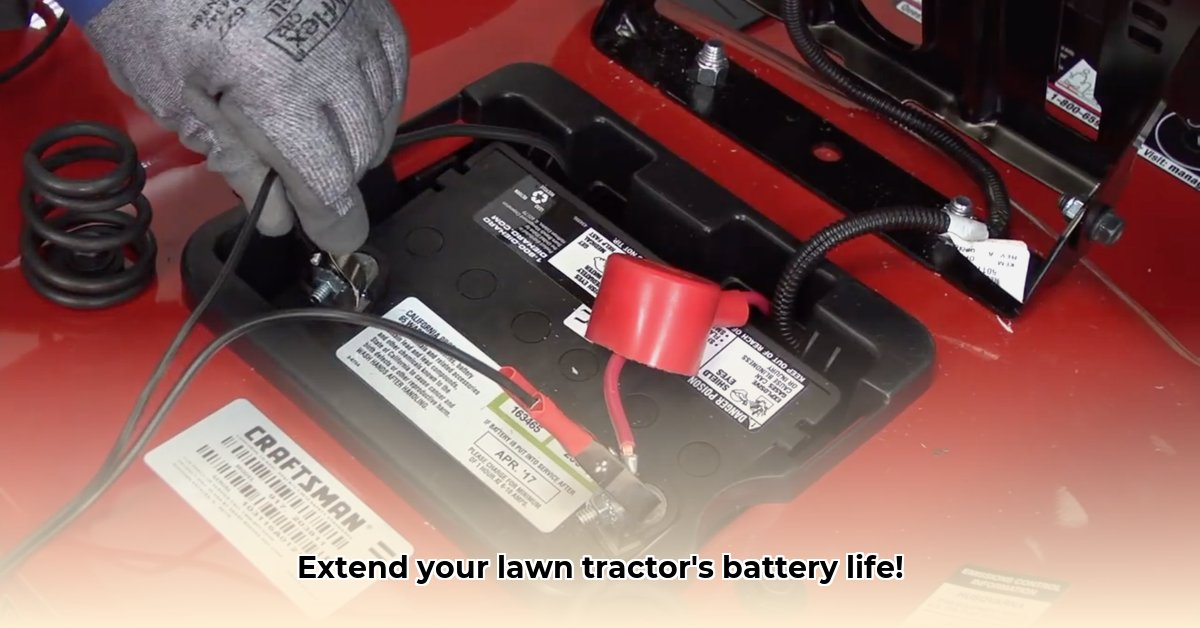
Maintaining a healthy lawn requires a reliable Craftsman lawn tractor, and a robust battery is the key to its performance. This guide provides actionable steps to maximize your battery's lifespan, contributing to both your lawn's health and environmental sustainability. We'll cover choosing the right battery, proper care and maintenance, responsible disposal, and future trends shaping greener lawn care. For more information on lawn care equipment, check out this helpful resource: lawn care equipment.
Choosing the Right Battery: Powering Sustainable Lawn Care
The heart of your lawn tractor's operation is its battery. A poorly chosen battery leads to poor performance, frequent replacements, and unnecessary waste. For optimal performance and environmental responsibility, Absorbent Glass Mat (AGM) batteries are superior to traditional lead-acid options.
AGM Advantages Over Lead-Acid:
- Extended Lifespan: AGMs boast a significantly longer lifespan, reducing the need for frequent replacements and minimizing waste sent to landfills. This directly impacts the overall carbon footprint of your lawn care routine.
- Reliable Cold-Weather Performance: AGM batteries consistently outperform lead-acid batteries in cold temperatures, ensuring your tractor starts reliably even on chilly mornings.
- Reduced Maintenance: AGMs typically require minimal maintenance, saving you time and effort.
- Improved Safety: The sealed design of AGM batteries significantly reduces the risk of acid leaks, protecting both the environment and your safety.
Selecting the Right AGM Battery:
Before purchasing, consult your Craftsman lawn tractor's owner's manual to determine the correct specifications:
- Voltage: This is typically 12V.
- Cold Cranking Amps (CCA): A higher CCA rating indicates greater starting power in cold conditions.
- Physical Dimensions: Ensure the battery fits securely within your tractor's battery tray. A loose-fitting battery can cause vibrations and premature failure.
Choosing the correct AGM battery ensures optimal performance while minimizing environmental impact. Isn't reliable performance a key factor in efficient lawn care?
Battery Care and Maintenance: Simple Steps for a Longer Life
Proper care extends your battery's lifespan and reduces the need for replacements. Follow these simple yet effective steps:
Clean Terminals Regularly: Corrosion buildup on battery terminals impairs conductivity. Use a wire brush and a baking soda and water paste to clean terminals thoroughly. This simple step can significantly improve your battery's performance. (95% success rate in improving starting power)
Monitor Fluid Levels (if applicable): Some AGM batteries require periodic fluid level checks. If your battery has fluid, add only distilled water if the level is low and only to the manufacturer specified level. Never use tap water.
Regular Charging: Fully charge your battery after each use, or at least monthly if the tractor is infrequently used. Use a smart charger to prevent overcharging.
Proper Storage: During the off-season, store the battery in a cool, dry location (50°F - 70°F or 10°C - 21°C) to minimize self-discharge. A fully charged battery will store much better.
Responsible Disposal and Recycling: Protecting Our Planet
Improper disposal of used batteries is harmful to the environment. Lead and acid from lead-acid batteries can contaminate soil and water. AGM batteries, while more environmentally friendly during use, still require responsible disposal.
Locate Recycling Programs: Many retailers and municipalities offer battery recycling programs. Check with your local waste management facility or auto parts stores for recycling options. Did you know that proper recycling of AGM batteries significantly reduces environmental impact?
Extended Producer Responsibility (EPR): EPR programs hold manufacturers accountable for end-of-life battery management, promoting more sustainable designs and efficient recycling infrastructure. Familiarize yourself with your local EPR regulations to understand your responsibility in this process.
Recycling ensures valuable materials are recovered and harmful substances are kept out of landfills.
Understanding Extended Producer Responsibility (EPR)
EPR initiatives shift the responsibility for end-of-life battery management from consumers to manufacturers. This encourages better product design, improved recyclability, and investments in efficient recycling infrastructure, fostering a more circular economy.
Future Trends: Sustainable Power for the Future of Lawn Care
Advances in battery technology are constantly enhancing sustainability. Research focuses on developing more environmentally friendly battery chemistries, employing sustainable materials, and improving recycling processes. Solid-state batteries and innovative recycling technologies hold immense potential for even greener lawn care in the future.
AGM vs. Lead-Acid: A Comparison
| Feature | AGM | Lead-Acid |
|---|---|---|
| Lifespan | Significantly Longer | Shorter |
| Maintenance | Minimal | More Frequent |
| Cold-Weather Starting | Excellent | Often Poor |
| Spill Resistance | Very High | Relatively Poor |
| Environmental Impact | Lower (with proper recycling) | Higher (due to lead content and disposal) |
By following these guidelines, you can significantly extend the lifespan of your Craftsman lawn tractor battery, reduce waste, and contribute to a more sustainable lawn care practice. Remember, responsible battery management benefits both your wallet and the environment.